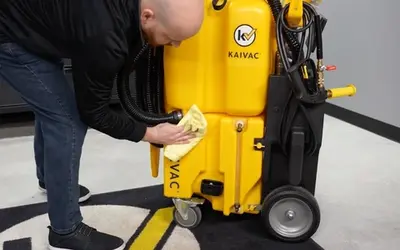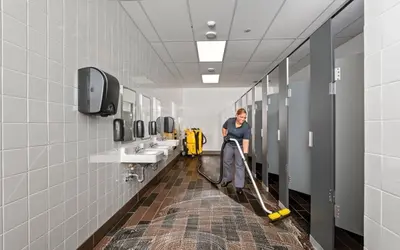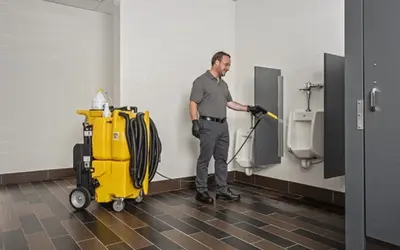Nowhere to Go: The Public Restroom Shortage

[et_pb_section][et_pb_row][et_pb_column type=”4_4″][et_pb_text]
If you’ve spent time away from home, you may have noticed it. The United States has a public restroom shortage. There are, of course, plenty of toilets out there, tucked away in shops, cafes, and other private establishments. But using these restrooms comes at a price. Workers only hand over the keys after a purchase is made.
This lack of access denies a basic human need to everyone who leaves their home. People running errands, visiting a park, traveling with children, or out during odd hours may find themselves with nowhere to go. Truckers, delivery people, and ride hail drivers are also affected. However, the public restroom shortage hits marginalized communities, like the unhoused or people experiencing disability, even harder.
“The state of public restrooms in the U.S. is pretty deplorable,” agrees Steven Soifer, president and co-founder of the American Restroom Association in this article from Bloomberg.
Clean, safe, accessible bathrooms are important to Kaivac. We talk a lot about how our No-Touch machines make restroom cleaning easy, complete, and fast. This same technology can also help ease some of the pain points causing the public restroom shortage.
Here’s a look at the scope of the problem and some ideas on how to help.
Why the Restroom Shortage is so Widespread
When compared to Europe and Asia, our public restroom shortage looks stark. The U.S. has only eight toilets per 100,000 people overall tied with Botswana, according to the public toilet index.
This was not always the case. In the 1970s there were over 50,000 pay toilets in the U.S. spread out in airports, bus stations, malls, and gas stations. Charging people to use facilities, however, created another set of equity issues. Only the toilets were locked behind stall doors. Urinals remained out in the open for men to use freely.
Over the next 10 years these pay-to-play options fell out of favor. While free access proved to be a good step forward, it did not change the fact that these restrooms are on private property so business owners could deny access at any time. Starbucks, for example, famously proclaimed their restrooms open to all in 2018. Now, the company is contemplating restricting use to paying customers only once again.
Lack of Restrooms Creates Health Issues
This lack of restroom access can worsen or create health problems for people with medical issues like Crohn’s Disease and diabetes or any condition that causes more frequent trips to the restroom. Medications for kidney disease and high blood pressure can also increase urination. In these cases, the public restroom shortage can cause bowel and bladder disorders, according to this article in Axios.
Even more alarming, the lack of public restrooms is contributing to an uptick of Hepatitis A. Transmitted by contact with human fecal matter, the virus is infecting unhoused people with no access to sanitation and others like urban gardeners who come in contact contaminated soils.
High Costs and Cleaning Issues
Adding more accessible public facilities seems like the no-brainer solution to the public restroom shortage. But creating new restrooms comes at a steep cost. The City of Los Angeles estimates that it will cost more than $300,000 a year to operate a single mobile restroom station. Most of that cost goes to staffing the space.
But even public restrooms already in place are often unusable because they are disgustingly dirty and have no soap or toilet paper. It is not surprising. Restrooms are consistently considered the hardest, most unpleasant area to service, according to this survey in Cleaning and Maintenance Management.
How Kaivac can Help
Solving the public restroom shortage will not be easy. Some argue that going back to pay toilets is the answer. That is, in fact, the system we have now as anyone who has seen a “restrooms are for customers only” sign can attest.
Business owners can offer their restrooms to non-paying customers at their discretion. They may hold back because cleaning restrooms is hard, and they may not have enough staff to do the job.
This is where Kaivac can help.
Our No-Touch Cleaning® system turns a dirty, unpleasant job into a quick, easy task. Workers simply:
- Spray fixtures, walls, and floors with cleaning solution
- Blast soils to the floor with a high-pressure rinse
- Vacuum the floor to leave restrooms sparkling clean, dry, and ready to use
The process is simple and fast. And because the system is no-touch, workers never have to handle disgusting surfaces.
Fixing our public restroom shortage will take time, effort, and a variety of strategies. But better cleaning protocols, if they make opening private restrooms to more people easier, can help ease the issue right now.
[/et_pb_text][/et_pb_column][/et_pb_row][/et_pb_section]
Related Posts

Preventive Maintenance for Your No-Touch Cleaning® System
Your Kaivac No-Touch Cleaning system makes restroom maintenance fast and easy. Keeping your No-Touch Cleaning system in good working order is also fast and easy. Kaivac makes performing preventative maintenance and troubleshooting potential issues simple. No special equipment or technical expertise required.
Read more
How to Clean a School Restroom
Clean school restrooms create a safe, welcoming environment. Students, staff, and parents expect sanitary conditions, especially in the restrooms. Anything less immediately effects morale and impacts learning.
Read more
Cherokee County School District Takes Cleaning into Their Own Hands With Kaivac
Each of the district’s six high schools maintained their restrooms with a No-Touch Cleaning system from Kaivac.
Read more